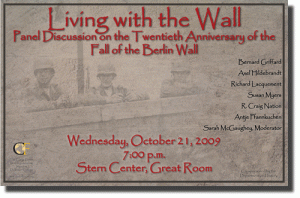Panel Discussion on the
Twentieth Anniversary of the
Fall of the Berlin Wall
Wednesday, October 21, 2009
Stern Center, Great Room, 7:00 p.m.
For close to thirty years a wall separated East from West Berlin. Members of Dickinson College and the broader community who experienced life in Berlin during this time will discuss how the period’s experiences affected their personal and professional lives.
Panelists
Bernard Griffard, professor of strategic logistics, Center for Strategic Leadership, U.S. Army War College
Axel Hildebrandt, assistant professor of German, Moravian College
Richard Lacquement, professor of military strategy, Department of National Security and Strategy, U.S. Army War College
Susan Myers, professor of distance education, Department of Distance Education, U.S. Army War College
R. Craig Nation, director of Eurasian studies, Department of National Security and Strategy, U.S. Army War College
Antje Pfannkuchen, instructor in German, Dickinson College
Sarah McGaughey (Moderator), assistant professor of German, Dickinson College
Topical Background
Following World War II, the Allied Powers divided Germany into four occupation zones. In 1949, the Soviet Union declared its occupation zone the German Democratic Republic (GDR), which quickly became known as East Germany. Over the next decade, hundreds of thousands of East Germans fled to West Berlin, an oasis of prosperity and freedom in the geographical center of the communist state. In August 1961, the East German government erected an 87 mile wire fence to stop the flow of refugees.
Over the next several decades, the wall was reconstructed several times. In 1965, concrete replaced the wire fence. Nonetheless, thousands still managed to cross into West Berlin. Ten years later, it was redone once again. This final version of the wall stood 12 feet tall and was fitted with barbed wire, fencing, and 116 watchtowers. More than 100 people died trying to cross into West Berlin before the wall was finally torn down in 1989, symbolizing the end of the Cold War.
Throughout four decades of division, the two Germanys provided a convenient, side-by-side comparison of two competing economic systems, as captured by the following quotation: “Real consumption expenditure by East German working families was only half the West German level. Because of higher labor participation rates, longer work weeks, and shorter vacations in the GDR, average East German living standards were much less than half the West German level during the late half of the 1980’s.” *
* Collier, Irwin and Horst Siebert. “The Economic Integration of Post-Wall Germany.” The American Economic Review (1991).

